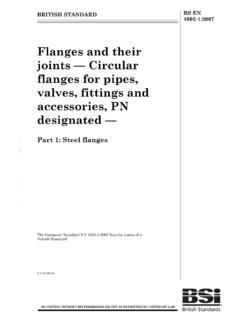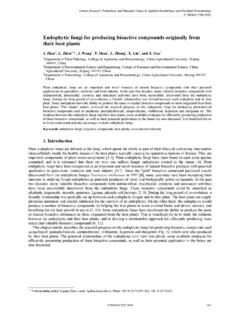Transcription of SharkFin Guide: identifying sharks for their fins
1 SharkFin GuideIDENTIFYING SHARKSFROM their FINSThe designations employed and the presentation of material in this information product do not imply the expression of any opinion whatsoever on the part of the Food and Agriculture Organization of the United Nations (FAO) concerning the legal or development status of any country, territory, city or area or of its authorities, or concerning the delimitation of its frontiers or boundaries. The mention of specific companies or products of manufacturers, whether or not these have been patented, does not imply that these have been endorsed or recommended by FAO in preference to others of a similar nature that are not views expressed in this information product are those of the author(s) and do not necessarily reflect the views or policies of 978-92-5-109131-9 FAO, 2016 FAO encourages the use, reproduction and dissemination of material in this information product.
2 Except where otherwise indicated, material may be copied, downloaded and printed for private study, research and teaching purposes, or for use in non-commercial products or services, provided that appropriate acknowledgement of FAO as the source and copyright holder is given and that FAO s endorsement of users views, products or services is not implied in any requests for translation and adaptation rights, and for resale and other commercial use rights should be made via or addressed to information products are available on the FAO website ( ) and can be purchased through photo:May 2014, Su-ao, Yinlan County, Taiwan Province of China - Lindsay J. Marshall and Jenny Giles photographing the finsof a mako shark atthe Su-ao fisheries landing site. FAO/Monica GuideIDENTIFYING SHARKSFROM their FINSbyLindsay J. MarshallandMonica BaroneRome, ItalyFOOD AND AGRICULTURE ORGANIZATION OF THE UNITED NATIONSRome, 2016 SharkFin GuidevSummaryThis publication covers 16 shark species that are globally distributed and are of major importance owing to either their conservation status or because they are a main target for the international trade in the guide focuses on fresh to partially dried first dorsal fins, pectoral fins and whole caudal fins.
3 The species are arranged in taxonomic order. For each species, a fact sheet instructs the user on the relevant diagnostic features and measurements of the dorsal, pectoral and caudal fins, showing a colour illustration of the whole shark , a distribution map and a photographic set of fins. For some species, photographs of pelvic, second dorsal and anal fins are also provided where practical and methodological section is included, guiding the users step by step through the identification of shark fins in different scenarios. It contains the user manual of the software iSharkFin and a practical protocol for the collection of the photographs as well as how to take the main technical measurements and the genetic guide : identifying sharks from their fins, by Lindsay J. Marshall and Monica Barone. Rome, Italy. Photo: FAO/Monica BaroneviSharkFin GuidePreparation of this documentThis document was prepared under the coordination of the Japanese Trust Fund Project CITES and Commercially-exploited Aquatic Species Including the Evaluation of Listing Proposals (Phase 2) with financial support from the Government of Japan, and the European Union through the Convention on International Trade in Endangered Species of Wild Fauna and Flora (CITES).
4 This guide was developed in close collaboration with the University of Vigo, Pontevedra, Spain, and the FAO FishFinder Programme of the Marine and Inland Fisheries Branch, Fisheries Department, Food and Agriculture Organization of the United Nations (FAO).The global demand for shark fins (a primary driver of shark mortality) and the inclusion of new shark species in the Appendix II of CITES in 2013 have been key considerations in promoting the preparation of this guide is a complementary tool to the software iSharkFin, developed in close collaboration with the University of Vigo, Pontevedra, Spain, and available at :Jorge Cervera HauserSharkFin GuideviiAcknowledgementsThe authors would like to express their gratitude to Johanne Fischer, Executive Secretary, South Pacific Regional Fisheries Management Organization and former Senior Fishery Resources Officer, FAO Fisheries and Aquaculture Resources Use and Conservation Division, for supporting the idea of this publication and for her valuable advice.
5 Special thanks are due to Professor C stor Guisande Gonz lez, J rgen Andreas Heine and Elisa P rez Costas, University of Vigo (Pontevedra) Spain, for providing the Manual of the iSharkFin software and for their comments. Dave Ebert is acknowledged for his scientific supervision and guidance in the selection of the species for this guide . The authors thank Shelley Clarke for her priceless review of the guide before publication. Deep gratitude goes to Jenny Giles, NOAA National Marine Fisheries Service Forensic Laboratory, for her assistance in data collection, suggestions and review of the methodological section, and for writing the section on How to take tissue sampling for genetic analysis . The authors would also like to thank Haruko Hokusu, Tom De Meulenaer and David Morgan of the CITES Secretariat for facilitating the financial support for the collection of samples, and for their encouragement.
6 Thankfulness is also extended to Prof. Kwang-Ming Liu, Prof. Shoou-Jeng Joung and Dr. Hua-Hsun Hsu, from the National Taiwan Ocean University for their assistance in the collection of samples. Koen Ivens is sincerely acknowledged for the layout design of the desktop publication. Jorge Cervera Hauser and Rodrigo Friscione are greatly thanked for the wonderful underwater photographs they provided. The authors thank Sarah Fowler, Glenn Sant, Markus Burgener, Fabrizio Serena and Cecilia Mancusi for the time they dedicated to the review of the guide and their kind feedback. Appreciation is extended to the FAO colleagues of the FAO Fisheries and Aquaculture Resources Use and Conservation Division, Emanuela D Antoni for providing the scientific illustrations, Fabio Carocci for the distribution maps and Luigia Sforza for the facilitation of the publishing procedure and for her constant encouragement.
7 The publication was generously funded by the Government of Japan and GuideixSharkFin GuideContentsIntroduction 1 shark fisheries 2 Trade in shark commodities 3 Conservation and management of sharks 5 HOW TO USE THIS guide 13 shark fins technical terms 13 Key to fin types (dorsal, pectoral, caudal, etc.) 14 shark fins measurements 16 Glossary 25 FACT SHEETS 27 List of orders, families and species included in this guide 28 Rhincodon typus Smith, 1828 29 Carcharias taurus Rafinesque, 1810 32 Alopias superciliosus Lowe, 1841 35 Carcharodon carcharias (Linnaeus, 1758) 38 Isurus oxyrinchus Rafinesque, 1810 42 Isurus paucus Guitart Manday, 1966 46 Lamna nasus (Bonnaterre, 1788) 50 Carcharhinus falciformis (M ller and Henle, 1839) 54 Carcharhinus longimanus (Poey, 1861) 57 Carcharhinus obscurus (Lesueur, 1818) 60 Carcharhinus plumbeus (Nardo, 1827) 63 Galeocerdo cuvier (P ron and Lesueur, 1822) 66 Prionace glauca (Linnaeus, 1758) 69 Sphyrna lewini (Griffith and Smith, 1834) 72 Sphyrna mokarran (R ppell, 1837) 76 Sphyrna zygaena (Linnaeus, 1758)
8 79 PRACTICAL PROTOCOL FOR IDENTIFICATION OF FINS 85 Guidelines for the identification of one shark fin 85 Guidelines for the identification of a bag of fins 87 How to take standard photographs of shark fins 91 How to take tissue samples for genetic analysis 100 Bibliography 103 Apendix 1 - Manual of iSharkFin 111 Photo: Rodrigo FriscionexSharkFin GuideIntroduction1 INTRODUCTIONTwo of the basic guidelines of the International Plan of Action for the Conservation and Management of sharks (IPOA- sharks ) are reiterated in most shark management recommendations, policies and programmes, and remain as relevant today as they were in 1999: 1. facilitate improved species-specific catch and landings data and monitoring of shark catches ;2. facilitate the identification and reporting of species-specific biological and trade data .Over the last 15 years, there has been an increasing willingness to manage shark1 species, and many of the management measures recently adopted for sharks are intended to limit the practice of finning.
9 Regardless of the type of finning regulation in place ( fin to bodyweight ratio or fins naturally attached ), after the first point of landing, sharks are processed and the fins can become a separate trade product, which can be subject to further present SharkFin guide is a traditional field guide and is coupled with an innovative system, iSharkFin (FAO and University of Vigo, 2014). The idea for developing this set of tools came in response to the need of port inspectors, customs officers and any other enforcement agent facing the technical difficulty of assigning detached fins to the correct shark species. Indeed, this need has become more evident after the inclusion of new shark species in the Appendices of the Convention on International Trade in Endangered Species of Wild Fauna and Flora (CITES).This publication covers 16 shark species that are globally distributed and are of major importance owing to either their conservation status or the fact that they are main target species for the international trade in fins.
10 For each of these species, a fact sheet instructs the user on the relevant diagnostic features and measurements for the dorsal, pectoral and caudal fins, showing a photographic set of fins, a colour illustration of the whole shark , and a distribution map. This guide also contains a methodological section, guiding the users step by step to the identification of shark fins in several scenarios. It includes the user manual for the iSharkFin software and a practical guide for the collection of useful shark fin photographs, as well as guidance on how to take the main technical measurements and genetic improvement of a taxonomically specific data recording system for both shark fisheries and shark products in trade is of primary importance for the sustainable management and conservation of shark species, in every future development for shark management and conservation.

















